BMSK6005: Coaching and Mentoring Report on Unilever UK's Strategies
VerifiedAdded on 2022/10/01
|27
|6172
|206
Report
AI Summary
This report provides a comprehensive analysis of coaching and mentoring practices within Unilever UK Limited. It begins with an executive summary highlighting the importance of these methods in organizational success, followed by an introduction to the concepts of coaching and mentoring. The report then delves into an overview of Unilever UK, detailing its history, products, and commitment to employee development. A significant portion of the report is dedicated to comparing and contrasting coaching and mentoring, including their differences in task orientation, time duration, and focus on performance versus development. The GROW model of coaching is explained, along with its benefits. Finally, the report concludes by identifying the essential skills, attitudes, and behaviors required for effective leaders in coaching and mentoring roles, providing a valuable resource for understanding and implementing these practices within a corporate environment. The report also includes an analysis of the company's mentoring programs and how it empowers its employees to achieve their full potential. The report also provides a comprehensive understanding of the methods and programs used by Unilever UK to enhance employee skills and overall performance.
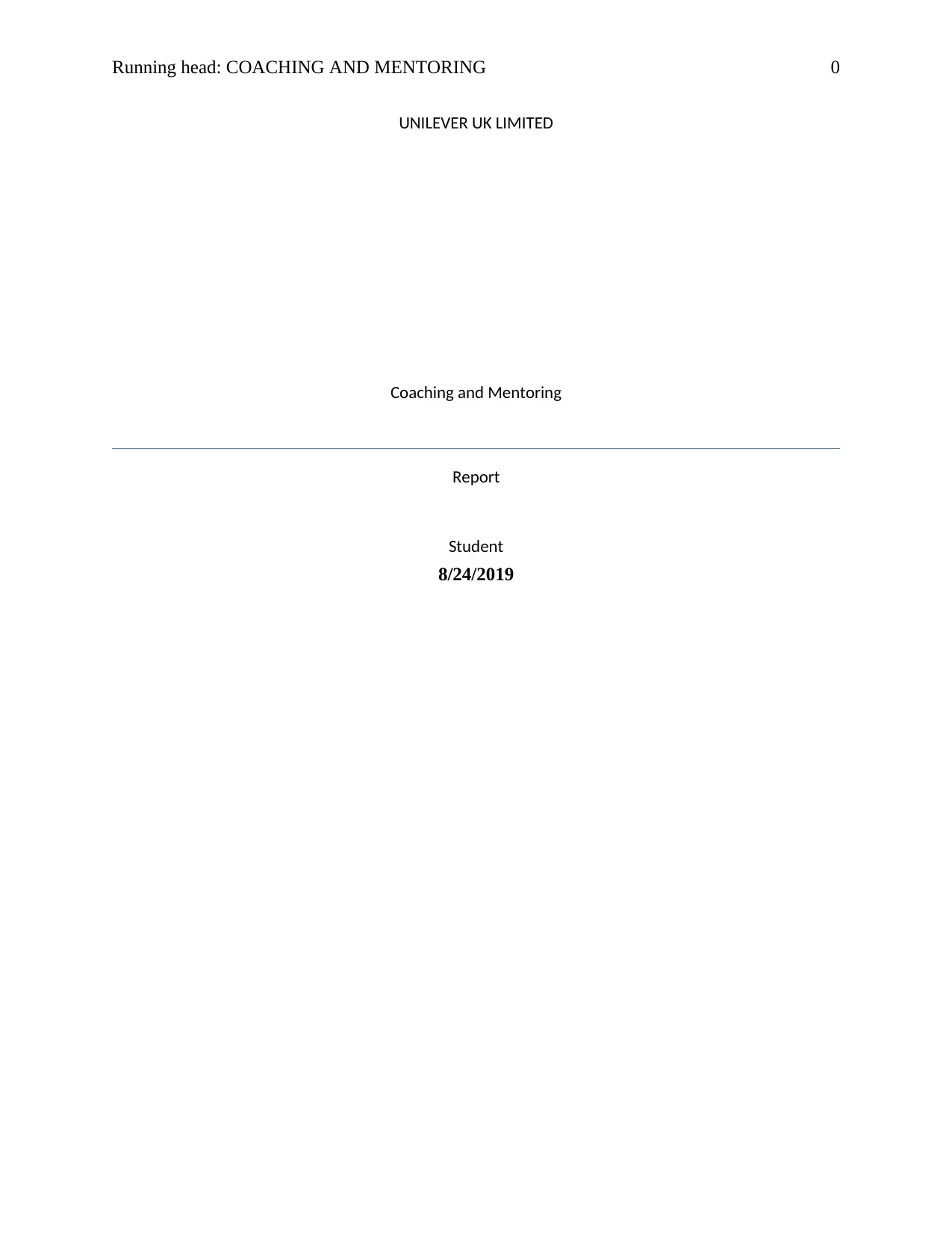
Running head: COACHING AND MENTORING 0
UNILEVER UK LIMITED
Coaching and Mentoring
Report
Student
8/24/2019
UNILEVER UK LIMITED
Coaching and Mentoring
Report
Student
8/24/2019
Paraphrase This Document
Need a fresh take? Get an instant paraphrase of this document with our AI Paraphraser
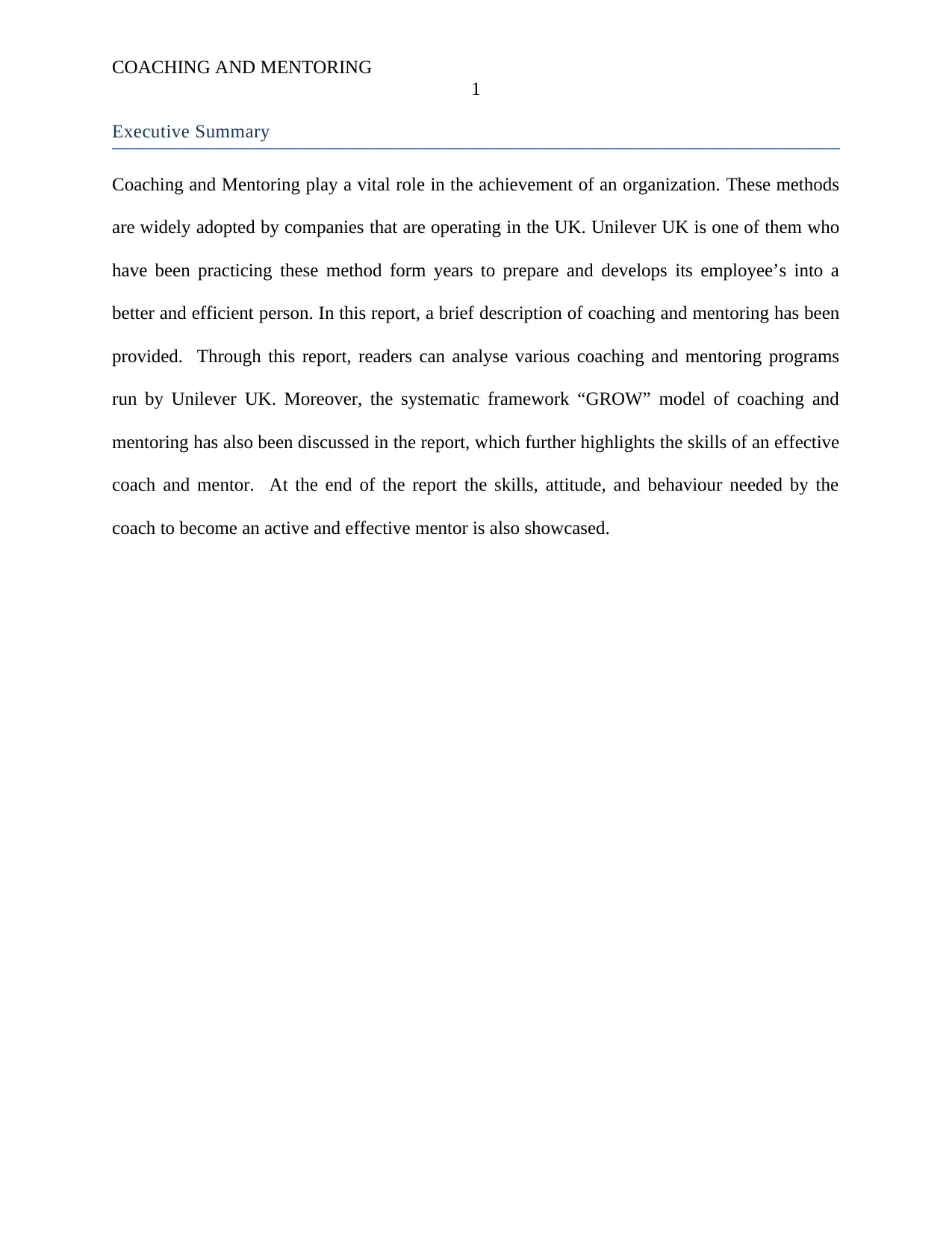
COACHING AND MENTORING
1
Executive Summary
Coaching and Mentoring play a vital role in the achievement of an organization. These methods
are widely adopted by companies that are operating in the UK. Unilever UK is one of them who
have been practicing these method form years to prepare and develops its employee’s into a
better and efficient person. In this report, a brief description of coaching and mentoring has been
provided. Through this report, readers can analyse various coaching and mentoring programs
run by Unilever UK. Moreover, the systematic framework “GROW” model of coaching and
mentoring has also been discussed in the report, which further highlights the skills of an effective
coach and mentor. At the end of the report the skills, attitude, and behaviour needed by the
coach to become an active and effective mentor is also showcased.
1
Executive Summary
Coaching and Mentoring play a vital role in the achievement of an organization. These methods
are widely adopted by companies that are operating in the UK. Unilever UK is one of them who
have been practicing these method form years to prepare and develops its employee’s into a
better and efficient person. In this report, a brief description of coaching and mentoring has been
provided. Through this report, readers can analyse various coaching and mentoring programs
run by Unilever UK. Moreover, the systematic framework “GROW” model of coaching and
mentoring has also been discussed in the report, which further highlights the skills of an effective
coach and mentor. At the end of the report the skills, attitude, and behaviour needed by the
coach to become an active and effective mentor is also showcased.
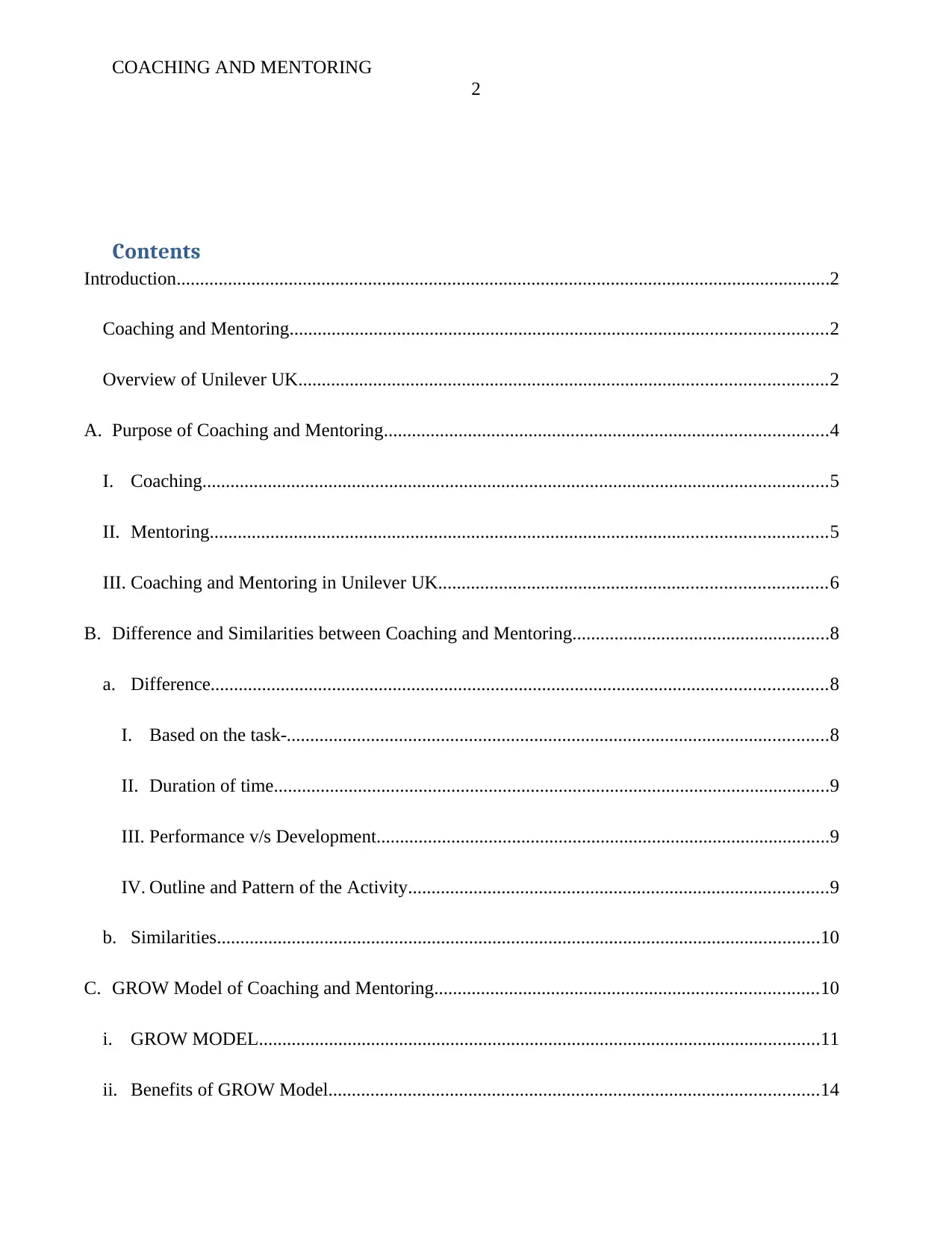
COACHING AND MENTORING
2
Contents
Introduction............................................................................................................................................2
Coaching and Mentoring...................................................................................................................2
Overview of Unilever UK.................................................................................................................2
A. Purpose of Coaching and Mentoring...............................................................................................4
I. Coaching......................................................................................................................................5
II. Mentoring....................................................................................................................................5
III. Coaching and Mentoring in Unilever UK...................................................................................6
B. Difference and Similarities between Coaching and Mentoring.......................................................8
a. Difference....................................................................................................................................8
I. Based on the task-....................................................................................................................8
II. Duration of time.......................................................................................................................9
III. Performance v/s Development.................................................................................................9
IV. Outline and Pattern of the Activity..........................................................................................9
b. Similarities.................................................................................................................................10
C. GROW Model of Coaching and Mentoring..................................................................................10
i. GROW MODEL........................................................................................................................11
ii. Benefits of GROW Model.........................................................................................................14
2
Contents
Introduction............................................................................................................................................2
Coaching and Mentoring...................................................................................................................2
Overview of Unilever UK.................................................................................................................2
A. Purpose of Coaching and Mentoring...............................................................................................4
I. Coaching......................................................................................................................................5
II. Mentoring....................................................................................................................................5
III. Coaching and Mentoring in Unilever UK...................................................................................6
B. Difference and Similarities between Coaching and Mentoring.......................................................8
a. Difference....................................................................................................................................8
I. Based on the task-....................................................................................................................8
II. Duration of time.......................................................................................................................9
III. Performance v/s Development.................................................................................................9
IV. Outline and Pattern of the Activity..........................................................................................9
b. Similarities.................................................................................................................................10
C. GROW Model of Coaching and Mentoring..................................................................................10
i. GROW MODEL........................................................................................................................11
ii. Benefits of GROW Model.........................................................................................................14
⊘ This is a preview!⊘
Do you want full access?
Subscribe today to unlock all pages.

Trusted by 1+ million students worldwide
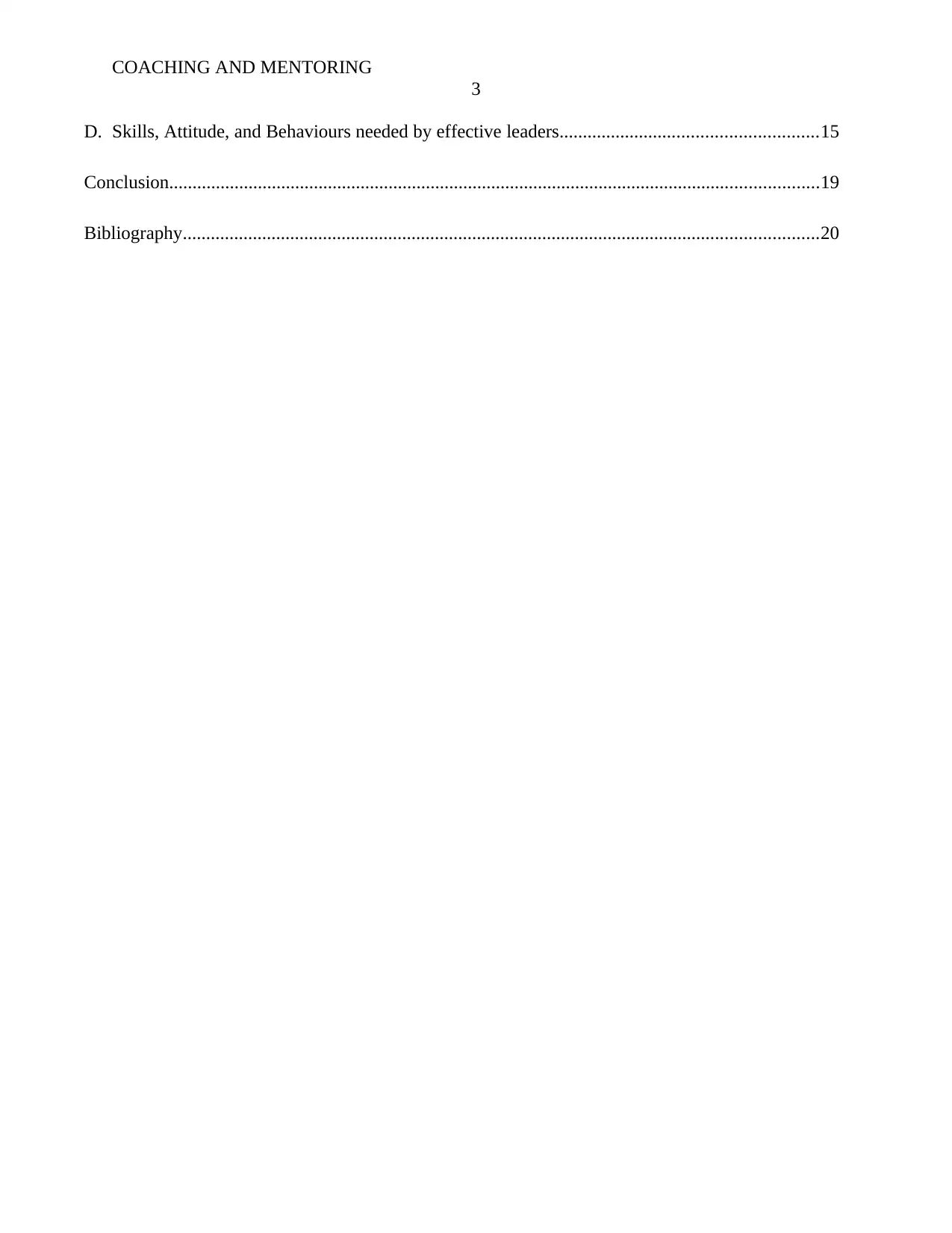
COACHING AND MENTORING
3
D. Skills, Attitude, and Behaviours needed by effective leaders.......................................................15
Conclusion...........................................................................................................................................19
Bibliography........................................................................................................................................20
3
D. Skills, Attitude, and Behaviours needed by effective leaders.......................................................15
Conclusion...........................................................................................................................................19
Bibliography........................................................................................................................................20
Paraphrase This Document
Need a fresh take? Get an instant paraphrase of this document with our AI Paraphraser
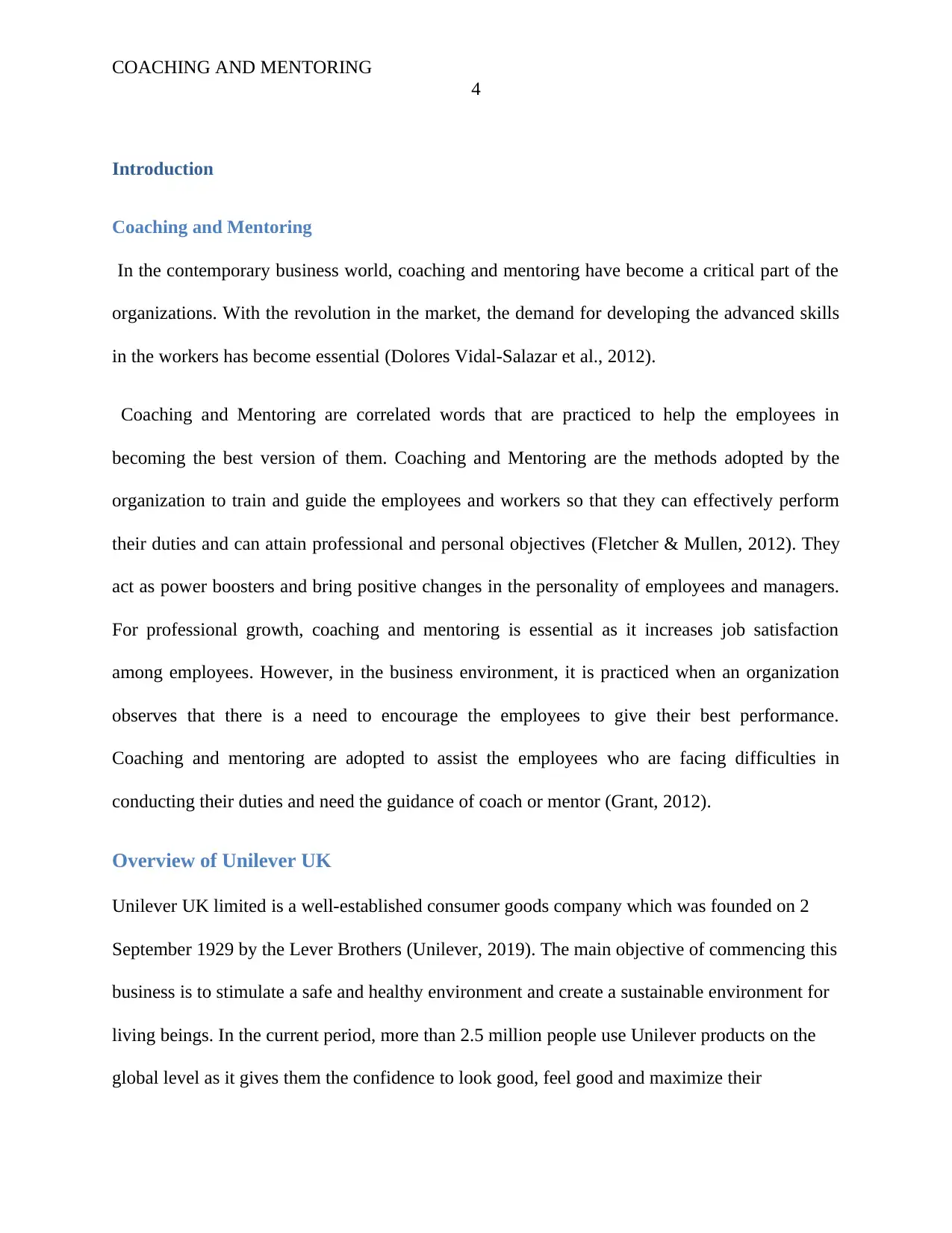
COACHING AND MENTORING
4
Introduction
Coaching and Mentoring
In the contemporary business world, coaching and mentoring have become a critical part of the
organizations. With the revolution in the market, the demand for developing the advanced skills
in the workers has become essential (Dolores Vidal-Salazar et al., 2012).
Coaching and Mentoring are correlated words that are practiced to help the employees in
becoming the best version of them. Coaching and Mentoring are the methods adopted by the
organization to train and guide the employees and workers so that they can effectively perform
their duties and can attain professional and personal objectives (Fletcher & Mullen, 2012). They
act as power boosters and bring positive changes in the personality of employees and managers.
For professional growth, coaching and mentoring is essential as it increases job satisfaction
among employees. However, in the business environment, it is practiced when an organization
observes that there is a need to encourage the employees to give their best performance.
Coaching and mentoring are adopted to assist the employees who are facing difficulties in
conducting their duties and need the guidance of coach or mentor (Grant, 2012).
Overview of Unilever UK
Unilever UK limited is a well-established consumer goods company which was founded on 2
September 1929 by the Lever Brothers (Unilever, 2019). The main objective of commencing this
business is to stimulate a safe and healthy environment and create a sustainable environment for
living beings. In the current period, more than 2.5 million people use Unilever products on the
global level as it gives them the confidence to look good, feel good and maximize their
4
Introduction
Coaching and Mentoring
In the contemporary business world, coaching and mentoring have become a critical part of the
organizations. With the revolution in the market, the demand for developing the advanced skills
in the workers has become essential (Dolores Vidal-Salazar et al., 2012).
Coaching and Mentoring are correlated words that are practiced to help the employees in
becoming the best version of them. Coaching and Mentoring are the methods adopted by the
organization to train and guide the employees and workers so that they can effectively perform
their duties and can attain professional and personal objectives (Fletcher & Mullen, 2012). They
act as power boosters and bring positive changes in the personality of employees and managers.
For professional growth, coaching and mentoring is essential as it increases job satisfaction
among employees. However, in the business environment, it is practiced when an organization
observes that there is a need to encourage the employees to give their best performance.
Coaching and mentoring are adopted to assist the employees who are facing difficulties in
conducting their duties and need the guidance of coach or mentor (Grant, 2012).
Overview of Unilever UK
Unilever UK limited is a well-established consumer goods company which was founded on 2
September 1929 by the Lever Brothers (Unilever, 2019). The main objective of commencing this
business is to stimulate a safe and healthy environment and create a sustainable environment for
living beings. In the current period, more than 2.5 million people use Unilever products on the
global level as it gives them the confidence to look good, feel good and maximize their
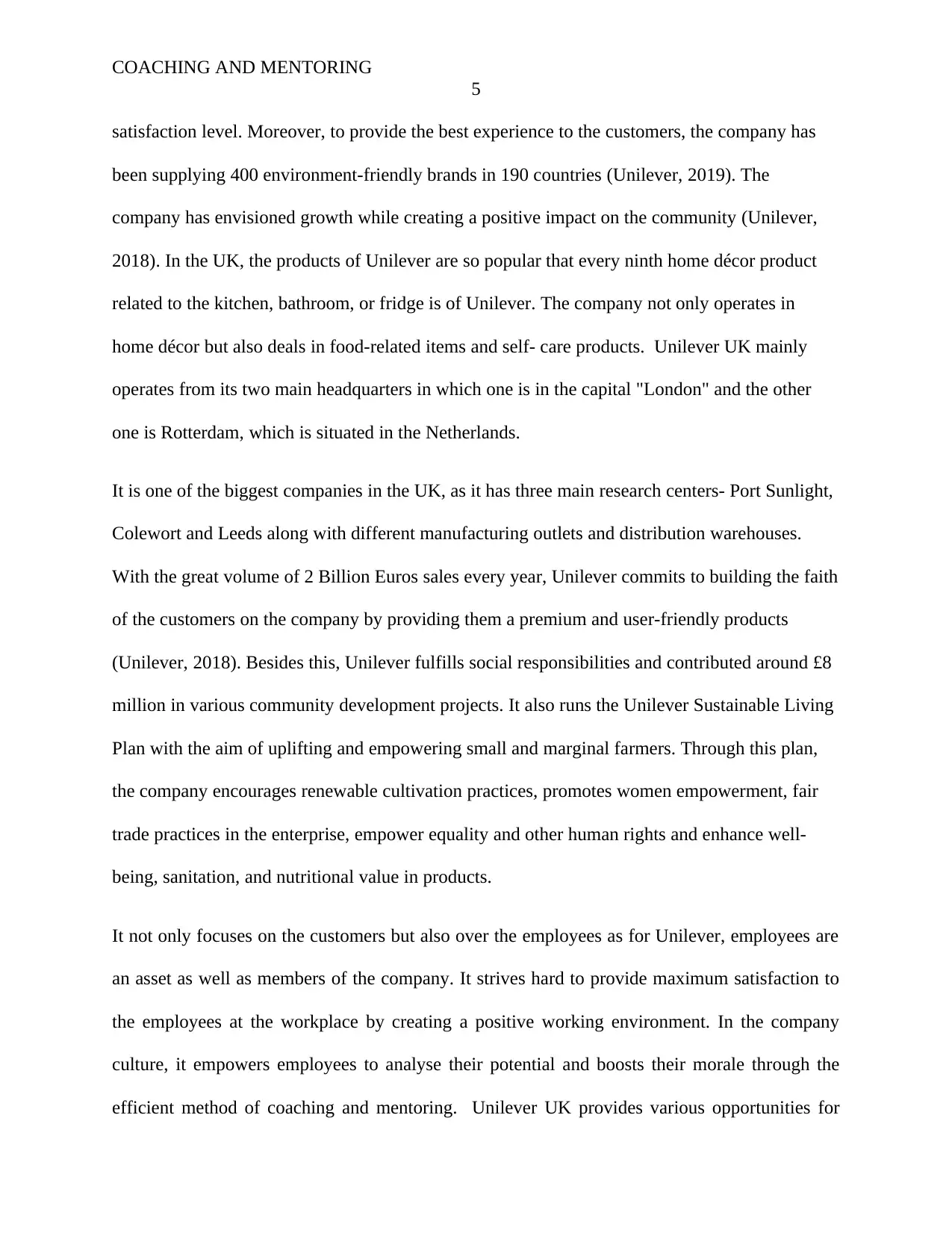
COACHING AND MENTORING
5
satisfaction level. Moreover, to provide the best experience to the customers, the company has
been supplying 400 environment-friendly brands in 190 countries (Unilever, 2019). The
company has envisioned growth while creating a positive impact on the community (Unilever,
2018). In the UK, the products of Unilever are so popular that every ninth home décor product
related to the kitchen, bathroom, or fridge is of Unilever. The company not only operates in
home décor but also deals in food-related items and self- care products. Unilever UK mainly
operates from its two main headquarters in which one is in the capital "London" and the other
one is Rotterdam, which is situated in the Netherlands.
It is one of the biggest companies in the UK, as it has three main research centers- Port Sunlight,
Colewort and Leeds along with different manufacturing outlets and distribution warehouses.
With the great volume of 2 Billion Euros sales every year, Unilever commits to building the faith
of the customers on the company by providing them a premium and user-friendly products
(Unilever, 2018). Besides this, Unilever fulfills social responsibilities and contributed around £8
million in various community development projects. It also runs the Unilever Sustainable Living
Plan with the aim of uplifting and empowering small and marginal farmers. Through this plan,
the company encourages renewable cultivation practices, promotes women empowerment, fair
trade practices in the enterprise, empower equality and other human rights and enhance well-
being, sanitation, and nutritional value in products.
It not only focuses on the customers but also over the employees as for Unilever, employees are
an asset as well as members of the company. It strives hard to provide maximum satisfaction to
the employees at the workplace by creating a positive working environment. In the company
culture, it empowers employees to analyse their potential and boosts their morale through the
efficient method of coaching and mentoring. Unilever UK provides various opportunities for
5
satisfaction level. Moreover, to provide the best experience to the customers, the company has
been supplying 400 environment-friendly brands in 190 countries (Unilever, 2019). The
company has envisioned growth while creating a positive impact on the community (Unilever,
2018). In the UK, the products of Unilever are so popular that every ninth home décor product
related to the kitchen, bathroom, or fridge is of Unilever. The company not only operates in
home décor but also deals in food-related items and self- care products. Unilever UK mainly
operates from its two main headquarters in which one is in the capital "London" and the other
one is Rotterdam, which is situated in the Netherlands.
It is one of the biggest companies in the UK, as it has three main research centers- Port Sunlight,
Colewort and Leeds along with different manufacturing outlets and distribution warehouses.
With the great volume of 2 Billion Euros sales every year, Unilever commits to building the faith
of the customers on the company by providing them a premium and user-friendly products
(Unilever, 2018). Besides this, Unilever fulfills social responsibilities and contributed around £8
million in various community development projects. It also runs the Unilever Sustainable Living
Plan with the aim of uplifting and empowering small and marginal farmers. Through this plan,
the company encourages renewable cultivation practices, promotes women empowerment, fair
trade practices in the enterprise, empower equality and other human rights and enhance well-
being, sanitation, and nutritional value in products.
It not only focuses on the customers but also over the employees as for Unilever, employees are
an asset as well as members of the company. It strives hard to provide maximum satisfaction to
the employees at the workplace by creating a positive working environment. In the company
culture, it empowers employees to analyse their potential and boosts their morale through the
efficient method of coaching and mentoring. Unilever UK provides various opportunities for
⊘ This is a preview!⊘
Do you want full access?
Subscribe today to unlock all pages.

Trusted by 1+ million students worldwide
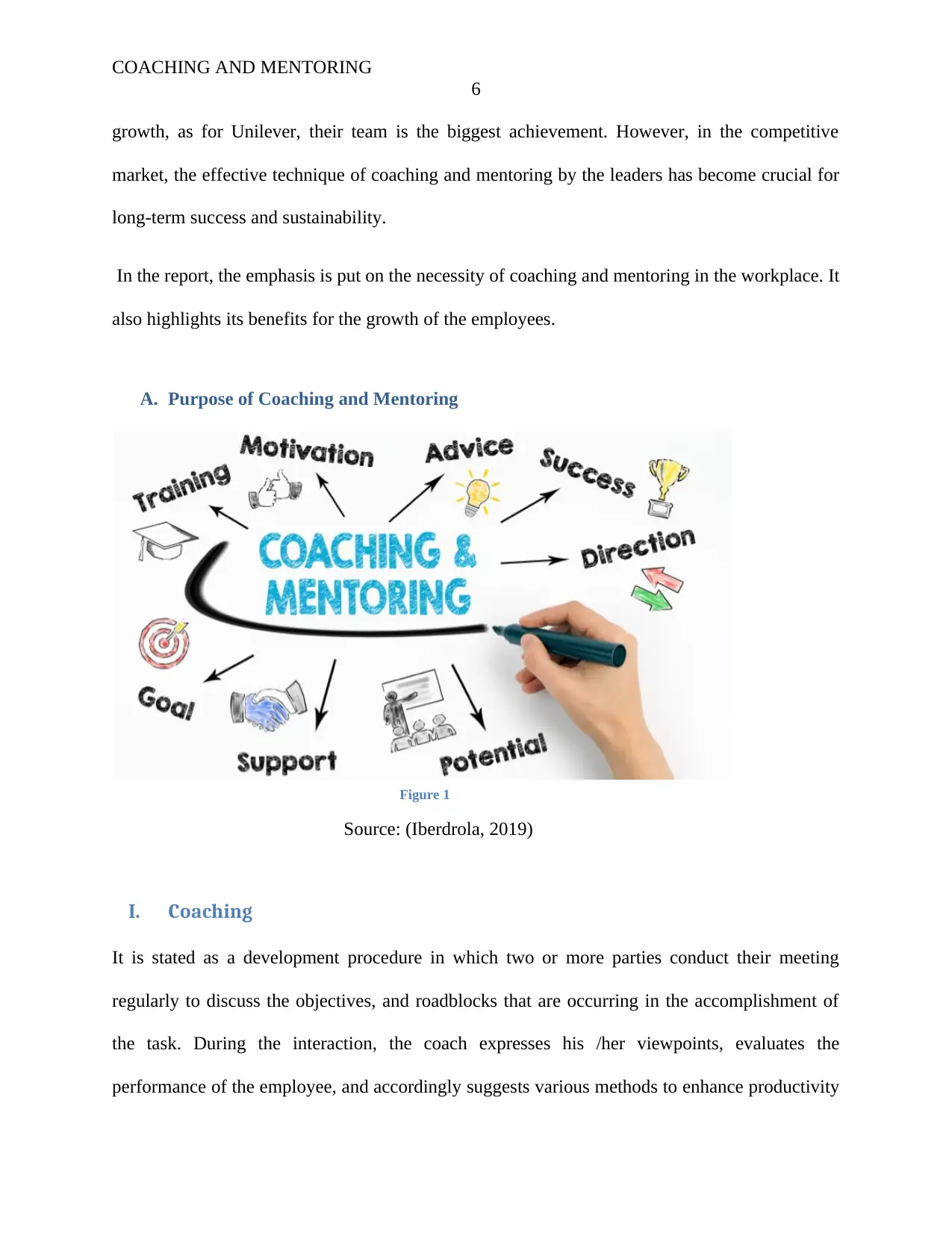
COACHING AND MENTORING
6
growth, as for Unilever, their team is the biggest achievement. However, in the competitive
market, the effective technique of coaching and mentoring by the leaders has become crucial for
long-term success and sustainability.
In the report, the emphasis is put on the necessity of coaching and mentoring in the workplace. It
also highlights its benefits for the growth of the employees.
A. Purpose of Coaching and Mentoring
I. Coaching
It is stated as a development procedure in which two or more parties conduct their meeting
regularly to discuss the objectives, and roadblocks that are occurring in the accomplishment of
the task. During the interaction, the coach expresses his /her viewpoints, evaluates the
performance of the employee, and accordingly suggests various methods to enhance productivity
Figure 1
Source: (Iberdrola, 2019)
6
growth, as for Unilever, their team is the biggest achievement. However, in the competitive
market, the effective technique of coaching and mentoring by the leaders has become crucial for
long-term success and sustainability.
In the report, the emphasis is put on the necessity of coaching and mentoring in the workplace. It
also highlights its benefits for the growth of the employees.
A. Purpose of Coaching and Mentoring
I. Coaching
It is stated as a development procedure in which two or more parties conduct their meeting
regularly to discuss the objectives, and roadblocks that are occurring in the accomplishment of
the task. During the interaction, the coach expresses his /her viewpoints, evaluates the
performance of the employee, and accordingly suggests various methods to enhance productivity
Figure 1
Source: (Iberdrola, 2019)
Paraphrase This Document
Need a fresh take? Get an instant paraphrase of this document with our AI Paraphraser
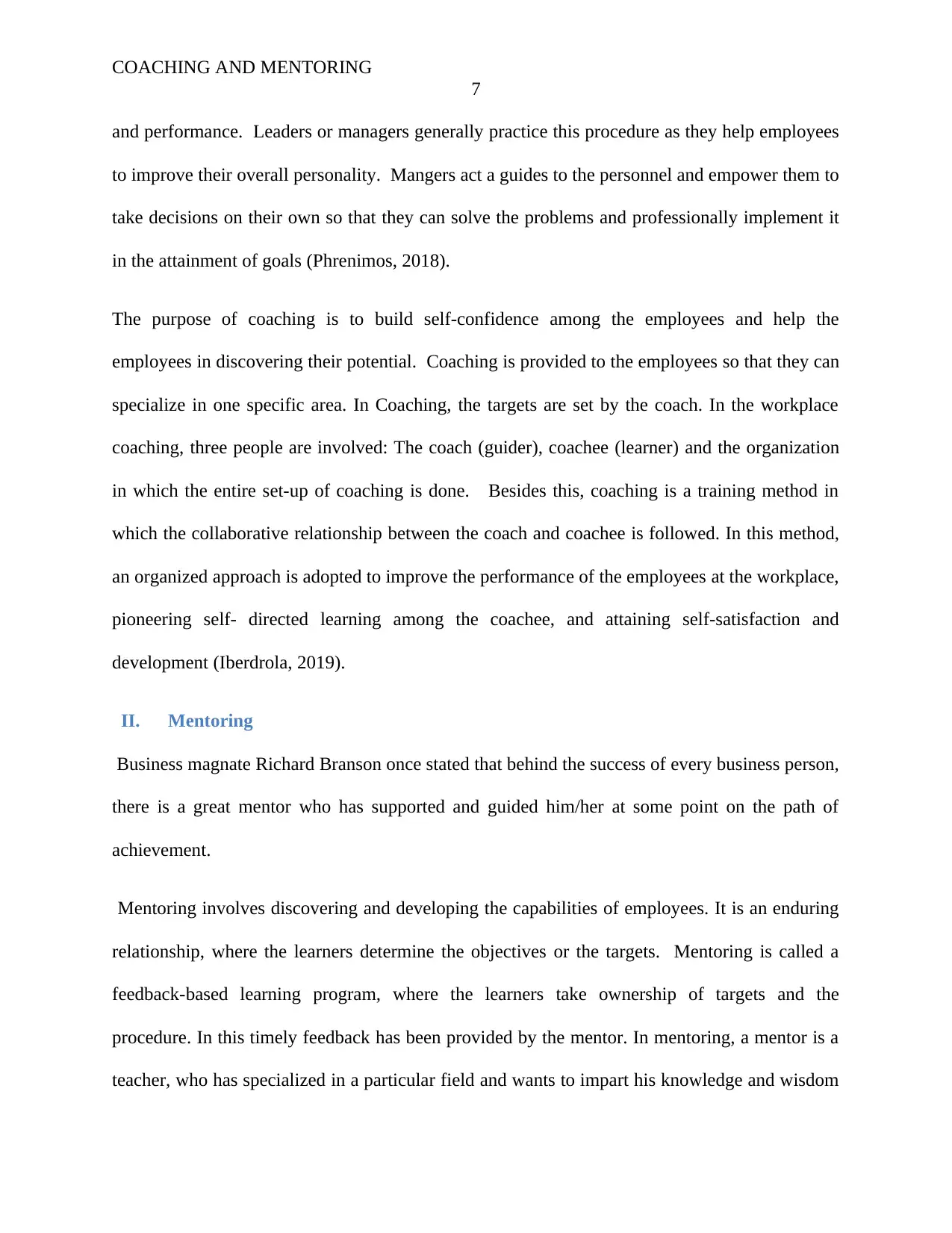
COACHING AND MENTORING
7
and performance. Leaders or managers generally practice this procedure as they help employees
to improve their overall personality. Mangers act a guides to the personnel and empower them to
take decisions on their own so that they can solve the problems and professionally implement it
in the attainment of goals (Phrenimos, 2018).
The purpose of coaching is to build self-confidence among the employees and help the
employees in discovering their potential. Coaching is provided to the employees so that they can
specialize in one specific area. In Coaching, the targets are set by the coach. In the workplace
coaching, three people are involved: The coach (guider), coachee (learner) and the organization
in which the entire set-up of coaching is done. Besides this, coaching is a training method in
which the collaborative relationship between the coach and coachee is followed. In this method,
an organized approach is adopted to improve the performance of the employees at the workplace,
pioneering self- directed learning among the coachee, and attaining self-satisfaction and
development (Iberdrola, 2019).
II. Mentoring
Business magnate Richard Branson once stated that behind the success of every business person,
there is a great mentor who has supported and guided him/her at some point on the path of
achievement.
Mentoring involves discovering and developing the capabilities of employees. It is an enduring
relationship, where the learners determine the objectives or the targets. Mentoring is called a
feedback-based learning program, where the learners take ownership of targets and the
procedure. In this timely feedback has been provided by the mentor. In mentoring, a mentor is a
teacher, who has specialized in a particular field and wants to impart his knowledge and wisdom
7
and performance. Leaders or managers generally practice this procedure as they help employees
to improve their overall personality. Mangers act a guides to the personnel and empower them to
take decisions on their own so that they can solve the problems and professionally implement it
in the attainment of goals (Phrenimos, 2018).
The purpose of coaching is to build self-confidence among the employees and help the
employees in discovering their potential. Coaching is provided to the employees so that they can
specialize in one specific area. In Coaching, the targets are set by the coach. In the workplace
coaching, three people are involved: The coach (guider), coachee (learner) and the organization
in which the entire set-up of coaching is done. Besides this, coaching is a training method in
which the collaborative relationship between the coach and coachee is followed. In this method,
an organized approach is adopted to improve the performance of the employees at the workplace,
pioneering self- directed learning among the coachee, and attaining self-satisfaction and
development (Iberdrola, 2019).
II. Mentoring
Business magnate Richard Branson once stated that behind the success of every business person,
there is a great mentor who has supported and guided him/her at some point on the path of
achievement.
Mentoring involves discovering and developing the capabilities of employees. It is an enduring
relationship, where the learners determine the objectives or the targets. Mentoring is called a
feedback-based learning program, where the learners take ownership of targets and the
procedure. In this timely feedback has been provided by the mentor. In mentoring, a mentor is a
teacher, who has specialized in a particular field and wants to impart his knowledge and wisdom
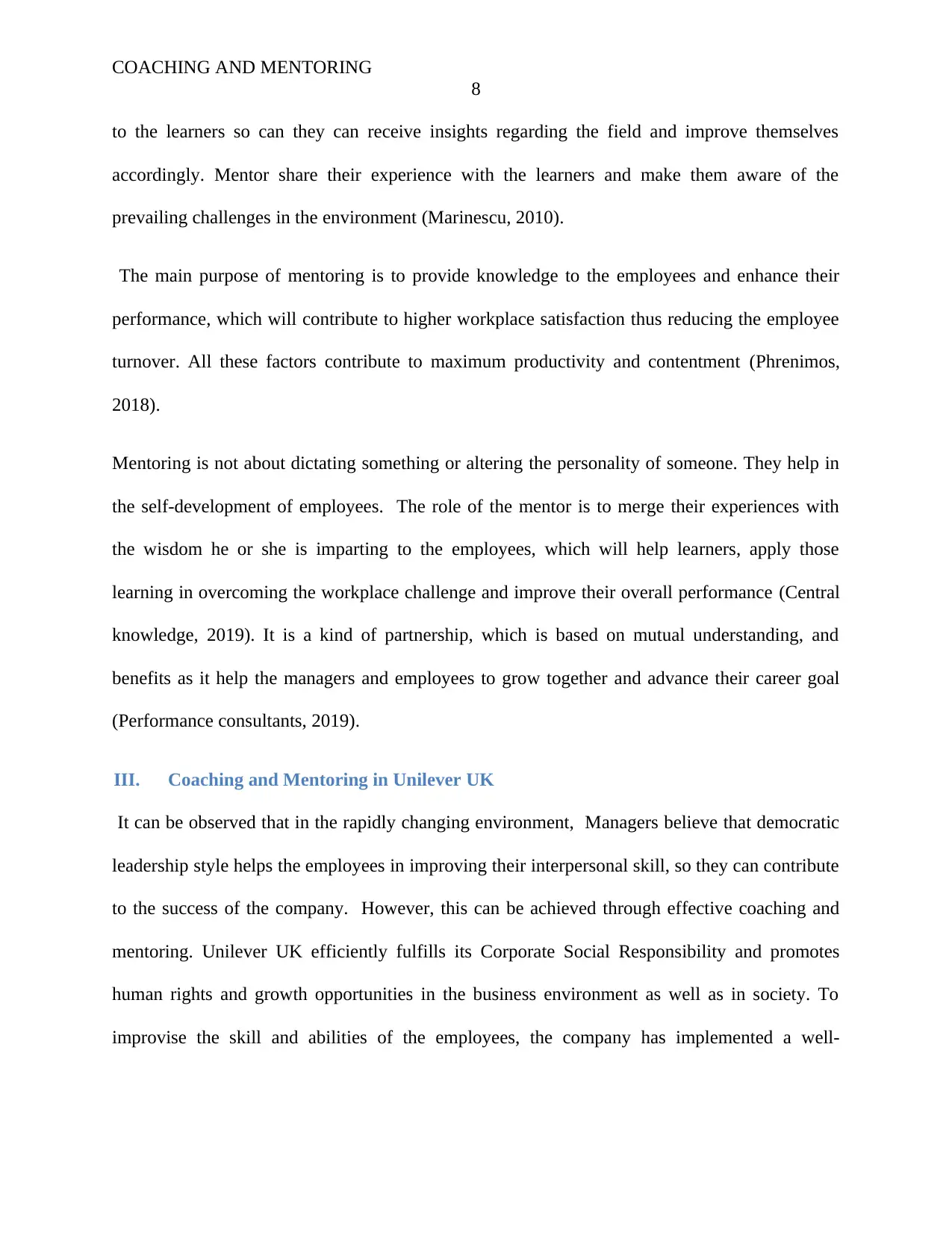
COACHING AND MENTORING
8
to the learners so can they can receive insights regarding the field and improve themselves
accordingly. Mentor share their experience with the learners and make them aware of the
prevailing challenges in the environment (Marinescu, 2010).
The main purpose of mentoring is to provide knowledge to the employees and enhance their
performance, which will contribute to higher workplace satisfaction thus reducing the employee
turnover. All these factors contribute to maximum productivity and contentment (Phrenimos,
2018).
Mentoring is not about dictating something or altering the personality of someone. They help in
the self-development of employees. The role of the mentor is to merge their experiences with
the wisdom he or she is imparting to the employees, which will help learners, apply those
learning in overcoming the workplace challenge and improve their overall performance (Central
knowledge, 2019). It is a kind of partnership, which is based on mutual understanding, and
benefits as it help the managers and employees to grow together and advance their career goal
(Performance consultants, 2019).
III. Coaching and Mentoring in Unilever UK
It can be observed that in the rapidly changing environment, Managers believe that democratic
leadership style helps the employees in improving their interpersonal skill, so they can contribute
to the success of the company. However, this can be achieved through effective coaching and
mentoring. Unilever UK efficiently fulfills its Corporate Social Responsibility and promotes
human rights and growth opportunities in the business environment as well as in society. To
improvise the skill and abilities of the employees, the company has implemented a well-
8
to the learners so can they can receive insights regarding the field and improve themselves
accordingly. Mentor share their experience with the learners and make them aware of the
prevailing challenges in the environment (Marinescu, 2010).
The main purpose of mentoring is to provide knowledge to the employees and enhance their
performance, which will contribute to higher workplace satisfaction thus reducing the employee
turnover. All these factors contribute to maximum productivity and contentment (Phrenimos,
2018).
Mentoring is not about dictating something or altering the personality of someone. They help in
the self-development of employees. The role of the mentor is to merge their experiences with
the wisdom he or she is imparting to the employees, which will help learners, apply those
learning in overcoming the workplace challenge and improve their overall performance (Central
knowledge, 2019). It is a kind of partnership, which is based on mutual understanding, and
benefits as it help the managers and employees to grow together and advance their career goal
(Performance consultants, 2019).
III. Coaching and Mentoring in Unilever UK
It can be observed that in the rapidly changing environment, Managers believe that democratic
leadership style helps the employees in improving their interpersonal skill, so they can contribute
to the success of the company. However, this can be achieved through effective coaching and
mentoring. Unilever UK efficiently fulfills its Corporate Social Responsibility and promotes
human rights and growth opportunities in the business environment as well as in society. To
improvise the skill and abilities of the employees, the company has implemented a well-
⊘ This is a preview!⊘
Do you want full access?
Subscribe today to unlock all pages.

Trusted by 1+ million students worldwide
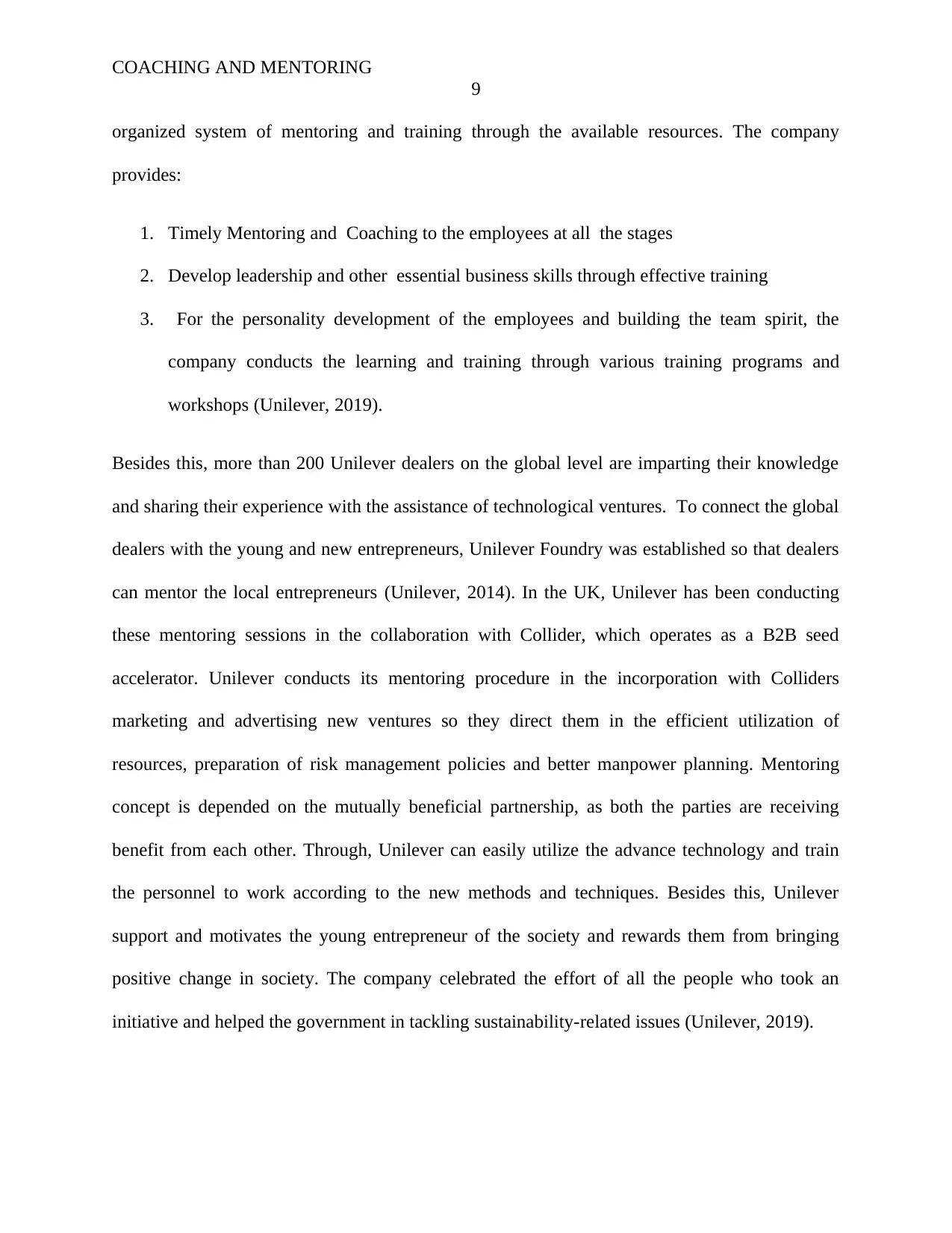
COACHING AND MENTORING
9
organized system of mentoring and training through the available resources. The company
provides:
1. Timely Mentoring and Coaching to the employees at all the stages
2. Develop leadership and other essential business skills through effective training
3. For the personality development of the employees and building the team spirit, the
company conducts the learning and training through various training programs and
workshops (Unilever, 2019).
Besides this, more than 200 Unilever dealers on the global level are imparting their knowledge
and sharing their experience with the assistance of technological ventures. To connect the global
dealers with the young and new entrepreneurs, Unilever Foundry was established so that dealers
can mentor the local entrepreneurs (Unilever, 2014). In the UK, Unilever has been conducting
these mentoring sessions in the collaboration with Collider, which operates as a B2B seed
accelerator. Unilever conducts its mentoring procedure in the incorporation with Colliders
marketing and advertising new ventures so they direct them in the efficient utilization of
resources, preparation of risk management policies and better manpower planning. Mentoring
concept is depended on the mutually beneficial partnership, as both the parties are receiving
benefit from each other. Through, Unilever can easily utilize the advance technology and train
the personnel to work according to the new methods and techniques. Besides this, Unilever
support and motivates the young entrepreneur of the society and rewards them from bringing
positive change in society. The company celebrated the effort of all the people who took an
initiative and helped the government in tackling sustainability-related issues (Unilever, 2019).
9
organized system of mentoring and training through the available resources. The company
provides:
1. Timely Mentoring and Coaching to the employees at all the stages
2. Develop leadership and other essential business skills through effective training
3. For the personality development of the employees and building the team spirit, the
company conducts the learning and training through various training programs and
workshops (Unilever, 2019).
Besides this, more than 200 Unilever dealers on the global level are imparting their knowledge
and sharing their experience with the assistance of technological ventures. To connect the global
dealers with the young and new entrepreneurs, Unilever Foundry was established so that dealers
can mentor the local entrepreneurs (Unilever, 2014). In the UK, Unilever has been conducting
these mentoring sessions in the collaboration with Collider, which operates as a B2B seed
accelerator. Unilever conducts its mentoring procedure in the incorporation with Colliders
marketing and advertising new ventures so they direct them in the efficient utilization of
resources, preparation of risk management policies and better manpower planning. Mentoring
concept is depended on the mutually beneficial partnership, as both the parties are receiving
benefit from each other. Through, Unilever can easily utilize the advance technology and train
the personnel to work according to the new methods and techniques. Besides this, Unilever
support and motivates the young entrepreneur of the society and rewards them from bringing
positive change in society. The company celebrated the effort of all the people who took an
initiative and helped the government in tackling sustainability-related issues (Unilever, 2019).
Paraphrase This Document
Need a fresh take? Get an instant paraphrase of this document with our AI Paraphraser
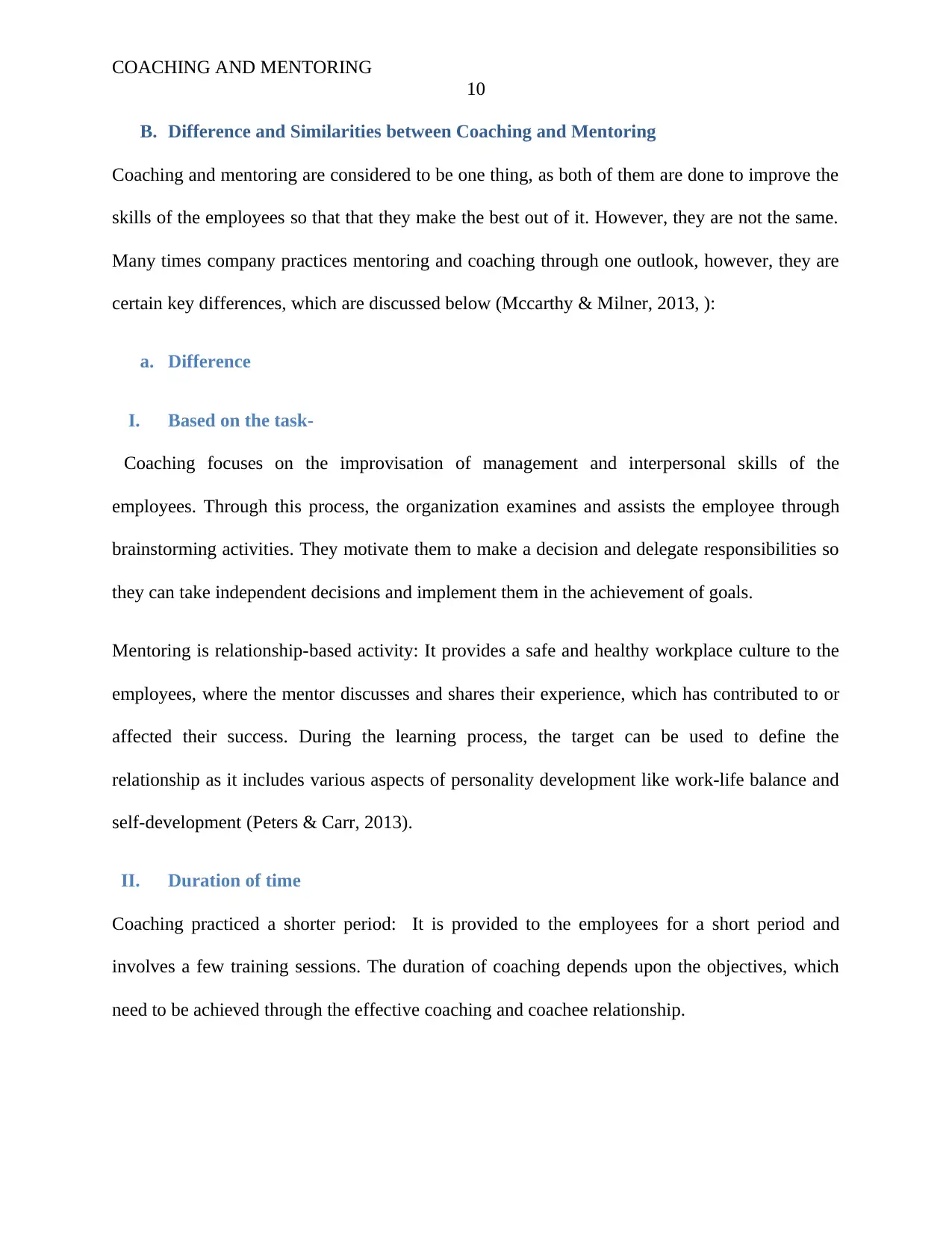
COACHING AND MENTORING
10
B. Difference and Similarities between Coaching and Mentoring
Coaching and mentoring are considered to be one thing, as both of them are done to improve the
skills of the employees so that that they make the best out of it. However, they are not the same.
Many times company practices mentoring and coaching through one outlook, however, they are
certain key differences, which are discussed below (Mccarthy & Milner, 2013, ):
a. Difference
I. Based on the task-
Coaching focuses on the improvisation of management and interpersonal skills of the
employees. Through this process, the organization examines and assists the employee through
brainstorming activities. They motivate them to make a decision and delegate responsibilities so
they can take independent decisions and implement them in the achievement of goals.
Mentoring is relationship-based activity: It provides a safe and healthy workplace culture to the
employees, where the mentor discusses and shares their experience, which has contributed to or
affected their success. During the learning process, the target can be used to define the
relationship as it includes various aspects of personality development like work-life balance and
self-development (Peters & Carr, 2013).
II. Duration of time
Coaching practiced a shorter period: It is provided to the employees for a short period and
involves a few training sessions. The duration of coaching depends upon the objectives, which
need to be achieved through the effective coaching and coachee relationship.
10
B. Difference and Similarities between Coaching and Mentoring
Coaching and mentoring are considered to be one thing, as both of them are done to improve the
skills of the employees so that that they make the best out of it. However, they are not the same.
Many times company practices mentoring and coaching through one outlook, however, they are
certain key differences, which are discussed below (Mccarthy & Milner, 2013, ):
a. Difference
I. Based on the task-
Coaching focuses on the improvisation of management and interpersonal skills of the
employees. Through this process, the organization examines and assists the employee through
brainstorming activities. They motivate them to make a decision and delegate responsibilities so
they can take independent decisions and implement them in the achievement of goals.
Mentoring is relationship-based activity: It provides a safe and healthy workplace culture to the
employees, where the mentor discusses and shares their experience, which has contributed to or
affected their success. During the learning process, the target can be used to define the
relationship as it includes various aspects of personality development like work-life balance and
self-development (Peters & Carr, 2013).
II. Duration of time
Coaching practiced a shorter period: It is provided to the employees for a short period and
involves a few training sessions. The duration of coaching depends upon the objectives, which
need to be achieved through the effective coaching and coachee relationship.
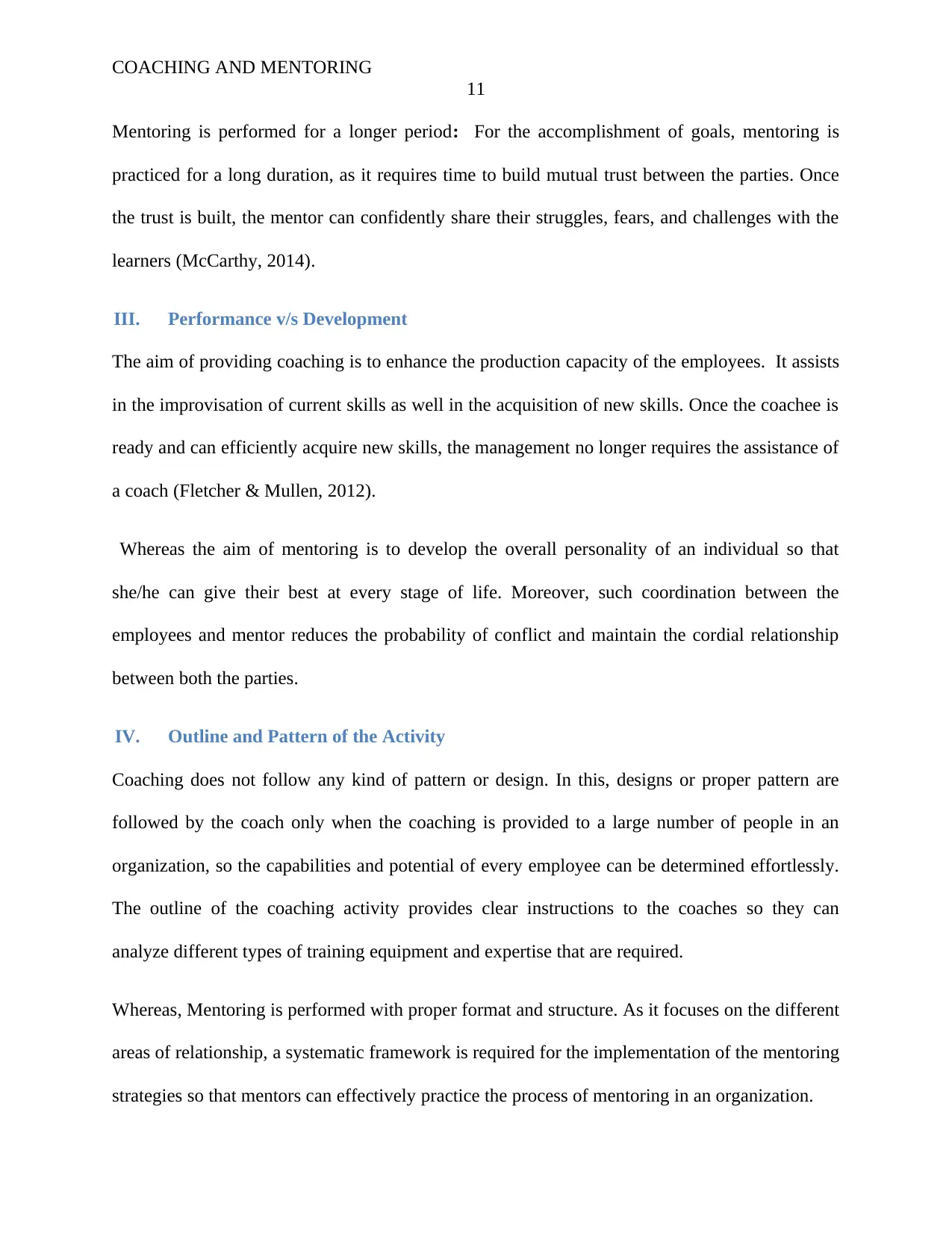
COACHING AND MENTORING
11
Mentoring is performed for a longer period: For the accomplishment of goals, mentoring is
practiced for a long duration, as it requires time to build mutual trust between the parties. Once
the trust is built, the mentor can confidently share their struggles, fears, and challenges with the
learners (McCarthy, 2014).
III. Performance v/s Development
The aim of providing coaching is to enhance the production capacity of the employees. It assists
in the improvisation of current skills as well in the acquisition of new skills. Once the coachee is
ready and can efficiently acquire new skills, the management no longer requires the assistance of
a coach (Fletcher & Mullen, 2012).
Whereas the aim of mentoring is to develop the overall personality of an individual so that
she/he can give their best at every stage of life. Moreover, such coordination between the
employees and mentor reduces the probability of conflict and maintain the cordial relationship
between both the parties.
IV. Outline and Pattern of the Activity
Coaching does not follow any kind of pattern or design. In this, designs or proper pattern are
followed by the coach only when the coaching is provided to a large number of people in an
organization, so the capabilities and potential of every employee can be determined effortlessly.
The outline of the coaching activity provides clear instructions to the coaches so they can
analyze different types of training equipment and expertise that are required.
Whereas, Mentoring is performed with proper format and structure. As it focuses on the different
areas of relationship, a systematic framework is required for the implementation of the mentoring
strategies so that mentors can effectively practice the process of mentoring in an organization.
11
Mentoring is performed for a longer period: For the accomplishment of goals, mentoring is
practiced for a long duration, as it requires time to build mutual trust between the parties. Once
the trust is built, the mentor can confidently share their struggles, fears, and challenges with the
learners (McCarthy, 2014).
III. Performance v/s Development
The aim of providing coaching is to enhance the production capacity of the employees. It assists
in the improvisation of current skills as well in the acquisition of new skills. Once the coachee is
ready and can efficiently acquire new skills, the management no longer requires the assistance of
a coach (Fletcher & Mullen, 2012).
Whereas the aim of mentoring is to develop the overall personality of an individual so that
she/he can give their best at every stage of life. Moreover, such coordination between the
employees and mentor reduces the probability of conflict and maintain the cordial relationship
between both the parties.
IV. Outline and Pattern of the Activity
Coaching does not follow any kind of pattern or design. In this, designs or proper pattern are
followed by the coach only when the coaching is provided to a large number of people in an
organization, so the capabilities and potential of every employee can be determined effortlessly.
The outline of the coaching activity provides clear instructions to the coaches so they can
analyze different types of training equipment and expertise that are required.
Whereas, Mentoring is performed with proper format and structure. As it focuses on the different
areas of relationship, a systematic framework is required for the implementation of the mentoring
strategies so that mentors can effectively practice the process of mentoring in an organization.
⊘ This is a preview!⊘
Do you want full access?
Subscribe today to unlock all pages.

Trusted by 1+ million students worldwide
1 out of 27
Related Documents
Your All-in-One AI-Powered Toolkit for Academic Success.
+13062052269
info@desklib.com
Available 24*7 on WhatsApp / Email
![[object Object]](/_next/static/media/star-bottom.7253800d.svg)
Unlock your academic potential
Copyright © 2020–2025 A2Z Services. All Rights Reserved. Developed and managed by ZUCOL.




